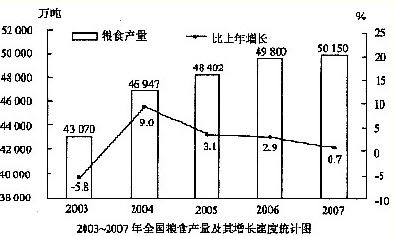问题
单项选择题
2007年我国粮食种植面积10553万公顷,比上年增加70万公顷;棉花种植面积559万公顷,增加7万公顷;油料种植面积1094万公顷,减少60万公顷;糖料种植面积167万公顷,增加10万公顷。
全年粮食产量50150万吨,比上年增加350万吨,增产0.7%,其中,夏粮产量11534万吨,增产1.3%;早稻产量3196万吨,增产0.3%;秋粮产量35420万吨,增产0.6%。

全年棉花产量760万吨,比上年增产1.3%。油料产量2461万吨,减产4.2%。糖料产量11110万吨,增产11.4%。烤烟产量239万吨,减产3.9%。茶叶产量114万吨,增产10.9%。
全年肉类总产量6800万吨,比上年减少3.5%。其中,猪肉减少9.2%;牛、羊肉分别增长6.1%和5.8%。全年水产品产量4737万吨,增长3.3%。全年木材产量6974万立方米,增长5.9%。
2002年我国的粮食产量约为()。
A.45722万吨
B.44965万吨
C.44761万吨
D.40709万吨
答案
参考答案:A
解析:
2003年全国粮食产量为43070万吨,增长率为-5.8%,则2002年全国粮食产量为43070÷(1-5.8%)≈45722万吨。
